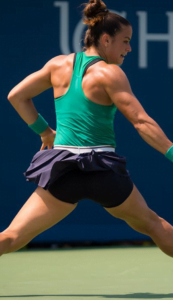Shoulder Manual for the Tennis Player
Note: There is a video of all the exercises at the bottom of this article! Don't miss it!
Most people are acutely aware that tennis players can develop a condition called tennis elbow. As the name implies, it is a common sports injury often seen in tennis players. However, living nearby is another joint that's even more important to talk about: the shoulder. You've heard the term "rotator cuff" before and you probably know it has something to do with the shoulder. However, for those who aren't doctors, your knowledge on the subject may begin and end right there. This brief shoulder manual for the tennis player can help you learn which muscles are involved, what they do, and how to improve your game by focusing on their injury prevention and strengthening.
So, What's a Rotator Cuff?
The rotator cuff is a group of four muscles that controls the rotation of your arm. An acronym to remember their anatomical names is "SITS": Supraspinatus, Infraspinatus, Teres minor, Subscapularis.

As you can see, all four muscles attach to different parts to the top of your arm. Subscapularis is a muscle that's hard to visualize: it sits between your shoulder blade and your ribcage. Here's what you need to know about them:
- Supraspinatus: Lifts the arm up from the side, such as the first half of the serve.
- Infraspinatus: Externally rotates the arm and assists in extension, such as during the back swing of a forehand.
- Teres minor: Helps infraspinatus in external rotation and extension.
- Subscapularis: Internally rotates the arm and brings it down, such as in the second half of a serve.

How Are These Muscles Used in Tennis?
In a forehand swing, the primary muscles used are in the chest and the rotator cuff muscles are stabilizers. In a backhand swing, the rotator cuff muscles are the primary muscles, as you can see flexing in the picture. Specifically: teres minor, infraspinatus, and supraspinatus.
We want these muscles to be flexible but strong. In this shoulder manual for the tennis player we'll go over a few stretches for flexibility, and a few exercises for strength.
The two exercises for flexibility: the sleeper stretch and the wall angel.
The two exercises for strength: the side plank and the Turkish get-up.
Sleeper Stretch
The sleeper stretch is a simple stretch that can be performed side-lying or standing. This helps improve the internal rotation of your shoulder and the flexibility of your infraspinatus and teres minor. Your place the back of your upper arm at chest-level in front of you with your lower arm reaching across the body. Then you bring your palm down toward the wall if standing, or ground if side-lying.
Wall Angel
Stand with your back against a wall and your feet about four inches away from the wall. Raise your arms and press your wrists, elbows, shoulders, and mid-back against the wall. Try to lower your hands down to head-level while keeping everything touching the wall.
Side Plank
Lay on your ground on your side with your elbow on the ground directly under the shoulder. Your body should be in a straight line from head to toe. Lift your body up, supporting your weight on your elbow and your feet. Hold for 30+ seconds if possible.
(First Half of) Turkish Get Up
Lay on your back with one leg straight and one leg bent with your foot on your ground. The side of your body with the bent leg holds the weight directly above your head towards the ceiling. Your other arm is out to the side. Rotate the weight 4 times inward and outward, keeping your eyes on the weight the entire time. Then press off the hand on the ground and move to a sitting position, still looking at the weight the entire time. This is an advanced exercise and should be performed under supervision the first time you perform it.
